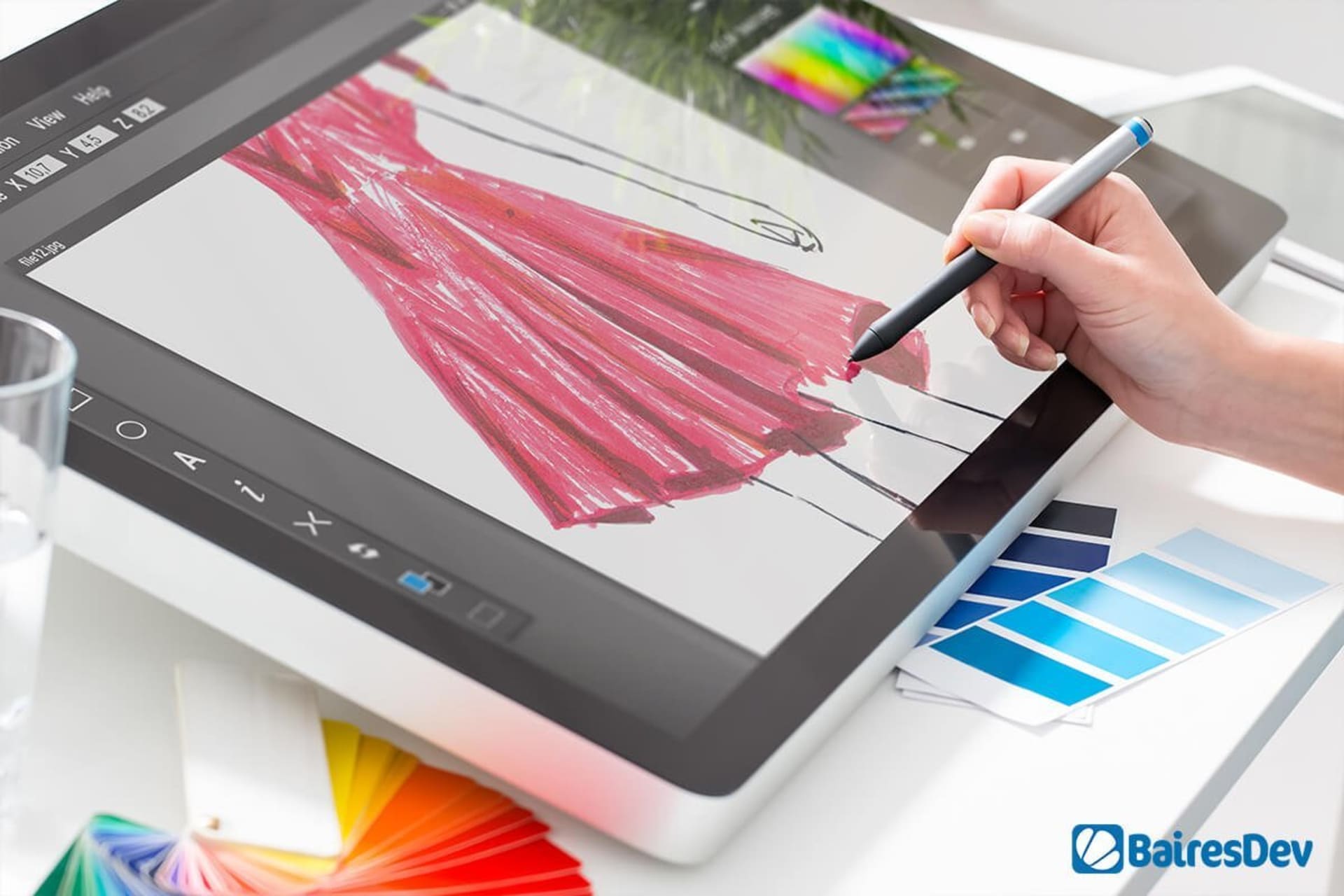Changing the industry for good
In the last couple of years, a specific topic has made its way into the heart of the fashion industry. It has been said, repeated, analyzed, and heatedly discussed, yet not everyone is on the same page about what it means. We’re talking about fashion tech.
Whenever someone mentions the combination of fashion and technology, most people start wondering about smart clothing and wearables. But as those many, many exchanges about it have shown, fashion tech is way more than just the new clothes we’ll be wearing in years to come. It’s also about new manufacturing processes, innovative materials, groundbreaking designs and even our whole relationship and experience with fashion.
In short, what we’re coming to understand as fashion tech has the potential to radically change fashion for good. Sounds exaggerated? It isn’t.
What’s fashion tech?
As we mentioned above, there isn’t a general agreement on what fashion tech means. But listening to various fashion experts and authority figures can provide us with a bigger picture that gets us closer to a definition that can be summed up like this:
Fashion tech is the merge of technology and fashion, which results in innovative ways to design, manufacture, market, shop, educate and experience the fashion industry. It’s the combination of new machines, materials, devices, digital platforms, cutting-edge technologies, and habits that reshape how we approach the concept of fashion.
Now that we got that out of the way, let’s look at the different ways technology is changing the fashion industry and what can we expect from the near future.
A solution to fashion’s industrial problems
All industries face their own set of manufacturing challenges, so why the fashion industry should be any different? Fortunately, the arrival of fashion tech is redefining the way clothes are manufactured while offering solutions to long-standing issues. Here are some of the ways technology is helping in fashion’s manufacturing process:
- Dealing with unsolved inventory: the current state of fashion (especially since the rise of fast fashion) has manufacturers supplying a massive inventory in a short period of time to meet an ever-growing demand. However, this has created a monstrous issue, as a massive amount of items aren’t sold and have to be disposed of somehow. This problem plagued the whole industry, which has tried to solve it by out letting the remaining inventory or by destroying it entirely.
None of those are true solutions for such issues. That’s when technology can make a difference, as it can shift the industry from supply chains to demand chains. Just by using blockchain technology, retailers and manufacturers can be part of a demand chain that accounts for the proper amount of items in stock while attending fluctuating demands.
- Adjusting prices to meet customer demands: another way to keep the unsolved inventory to a minimum is to use big data analysis coupled with machine learning and artificial intelligence to make more accurate predictions about seasonal shifts, identify up-and-coming trends, and adjust designs according to the target audience’s tastes and preferences.
By using the data gathered across the multiple interactions of customers, companies can use cutting edge technologies to better understand their clients’ needs. This, in turn, will help them better anticipate what will sell quicker and what can better entice the customer base, which will impulse-buy much more, as they’ll feel that designs are tailor-made for their needs.
- Keeping unethical practices in check: As you surely know by now, the fashion industry has an unfortunate long story of unethical practices to cut costs, mainly on the manufacturing plants where they offshore their labor. In that context, Blockchain can also serve a more altruistic purpose – holding companies accountable for everything that happens in their manufacturing chain.
By using blockchain across the fashion industry, there would be an increase in transparency. Manufacturing processes and dealings between companies would be stored in a chain where every member would be able to trace and track them. This, in turn, will force manufacturers to come clean about the items’ origins, which will increase the overall control of what happens in fashion’s backstage.
- Getting out of transactional hell: as any fashion insider can attest, the fashion industry’s transactions are massive chaos. There are countless contracts, orders, invoices, certifications, declarations, and documents flying around to increase trust between the different companies involved and leave a traceable route for control. This, of course, is a logistical nightmare that costs money, time and effort.
Once again, technology (and blockchain) have the answer to leave that old method behind – smart contracts. These are protocols that validate a specific contract, providing credibility to all transactions while removing the third parties needed today to act as control figures. Since smart contracts are stored in the chain’s blocks and can’t be tampered with, there’s no need to bring someone to safeguard them. That can reduce the amount of paperwork needed for all the transactions (while bringing down the costs) without resigning an ounce of trust.
A tech bet on new materials and clothes
Manufacturing processes aren’t the only thing that will be benefitted by the introduction of new technologies. The clothes themselves will obviously be revolutionized with the help of new materials and concepts that seem out of a sci-fi movie.
A fantastic example of this is how certain companies are experimenting with materials that are far from being the traditional options, with MycoTEX being one of the most impressive ones. That’s the name of a fabric made out of mushroom mycelium, the vegetative part of the mushroom. Dutch designer Aniela Hoitink says that the fabric doesn’t need chemicals and only needs to go through a few processes. She used it to create a dress that can take the shape of the wearer’s body and is seeking ways to mass-produce it.
Another interesting product is the one created by none other than Adidas – the Parley shoe line, which uses ocean plastic for certain parts. Additionally, the German brand is developing a wide range of products with the recycling concept at its core. The whole line uses recycling technology to reuse plastic that would otherwise end up in a landfill or the ocean and turn it into beautiful products.
Want more examples? The College of Optics and Photonics of the University of Central Florida has developed something amazing: a color-changing fabric that changes its tone according to the wearer’s desire and through an app. Thanks to a set of thin metal wires incorporated into the fabric and embedded with special pigments, the color changes depending on the fluctuations of temperature the user defines through the app.
Technology can take clothes into incredible directions, especially newer tech advancements like nanotechnology. For example, a group of researchers is working with nanostructures made out of 3D copper and silver structures to integrate them on cotton threads that are later used in clothing. Those nanostructures absorb sunlight, degrading the dirt and making the stains disappear in minutes.
These are but a few examples of the new exciting experiments companies are leading when combining technology and fashion. From clothes that can generate electricity to handbags that can display tweets, the future of clothing looks wilder than ever, thanks to the possibilities opened by all kinds of technology.
Fashion shopping will never be the same
One of the biggest changes technology introduced in the fashion industry several years ago has solidified and it’s now seen as a standard way of shopping – buying clothes online. Sure, e-commerce isn’t something exclusive to clothing but when the pioneers started to embrace online stores to sell clothes, many predicted that the endeavor was doomed to fail. Who would want to buy clothes that couldn’t be touched or tried on?
You’ve probably bought some clothes online by now, so you know how those predictions went. Ecommerce changed the way we shop for clothes and it’s a great example to illustrate how technology can radically modify fashion shopping beyond our habits. Though not potentially as big as e-commerce, there are other technologies that will surely change clothing stores in the near future.
Nike’s House of Innovation 000 is one of the brand’s most spectacular stores. Located in New York, it relies on several technologies to offer a unique experience to all visitors. For instance, there are customization studios where you can tailor-make your own shows through a digital platform, and automatic checkout points to make the exit quicker.
But probably the most impressive feature is the Speed Shop, which allows you to reserve an item online that will be waiting for you once you visit the store. You just have to access through a dedicated entrance, look for the locker with your name on it and unlock it with your smartphone. Want to buy the item you reserved? Just pay it through your mobile device and go home.
As you can see, Nike’s Speed Shop is just a combination of existing technologies brought together to redefine the shopping experience. That’s a great example because it shows that fashion tech isn’t just about never-heard-before trends but rather about fresh and innovative concepts that reshape the fashion world.
Another (rather more common) use of technology in the fashion stores can be seen across Zara’s locations – self-checkouts. One of the standards of modern supermarkets, the fashion retail chain embraced it in 2018 to wild success. The company installed kiosks where you need to put your clothes to be automatically billed. Once you’re done, you pay right there, through the same kiosk and leave with your items bagged and paid for.
Booming trends are already changing the fashion industry
As if all the above wasn’t enough, there are plenty of tech trends that already found their way into the fashion industry. Two of the biggest ones right now are augmented reality (AR) and big data analysis, which are fueling some of the most interesting and innovative modifications in the fashion experience.
On one hand, AR is being used by several brands to provide a shopping experience like you’ve never heard before. A good example is Lacoste’s LCST Lacoste AR app, which allows its users to try on shoes virtually just by pointing the built-in camera to one foot and rotating it around it.
Once again, Zara is proving to be at the forefront of fashion tech, since it’s also using AR in its stores. Just by pointing their app to an empty space or to an apparently naked mannequin, you can see clothing items appear out of nowhere to be modeled by virtual people. You can touch anything that appears on screen for more information and related items or just to buy it. This is a perfect example of how to bring a digital and physical experience together with excellent results.
On the other hand, there’s big data analysis, which is all the rage now across industries of all kinds. In the context of the fashion industry, companies are gathering information about their customers and their habits to use the insights for a number of things, including:
- Finding niches: by gathering data and analyzing it, it’s possible to determine which kind of items are among the most sold and what segment of the audience is buying it more. Thus, companies can detect opportunities that might have been overlooked before. For instance, big data can reveal that men of a certain age are more interested in scarves of a certain color and size, while women of the same age aren’t interested in them at all. This informs the manufacturing and marketing efforts and directions them in a more precise direction.
- Predicting trends: customers’ interests and desires change rapidly in today’s world, and more so in the fashion industry. Big data science allows for a precise prediction of new trends, leaving the days of guessing or betting behind. By gathering data from social media (especially more visually-laden platforms like Instagram and Pinterest), companies can identify emerging patterns in clothing and accessories and anticipate the moment when they reach critical mass. Thus, data analysis allows brands to become trendsetters by putting them in the right place at the right time.
- Setting prices: we’ve talked about this above but it bears repeating. The process to define the price of a specific item can be very complex, but thanks to big data analysis, it’s more streamlined than ever. That’s because big data can pull up information on previous similar items, compare their performance via their prices and simulate different prices to finally settle on an average one that will attract more buyers. All of that is done in a fraction of time, thanks to the use of artificial intelligence, that can process vast amounts of data in a short period of time. Additionally, when coupled with machine learning, the results can get more accurate over time, as algorithms “learn” from their past estimations.
Expanding the boundaries of fashion
After reading all of these examples and tech advancements applied to fashion, you can understand why we’re about to witness a colossal change in how we see fashion in general. The use of technology in the fashion world is coming up with new concepts and ideas that are pushing the boundaries in manufacturing, distribution, shopping, design, and even in the perception we all have about fashion.
There are so many experiments and developments happening right now that we’ll surely see some of them in the streets and store windows sooner rather than later. Are you ready for the new era of fashion tech?







